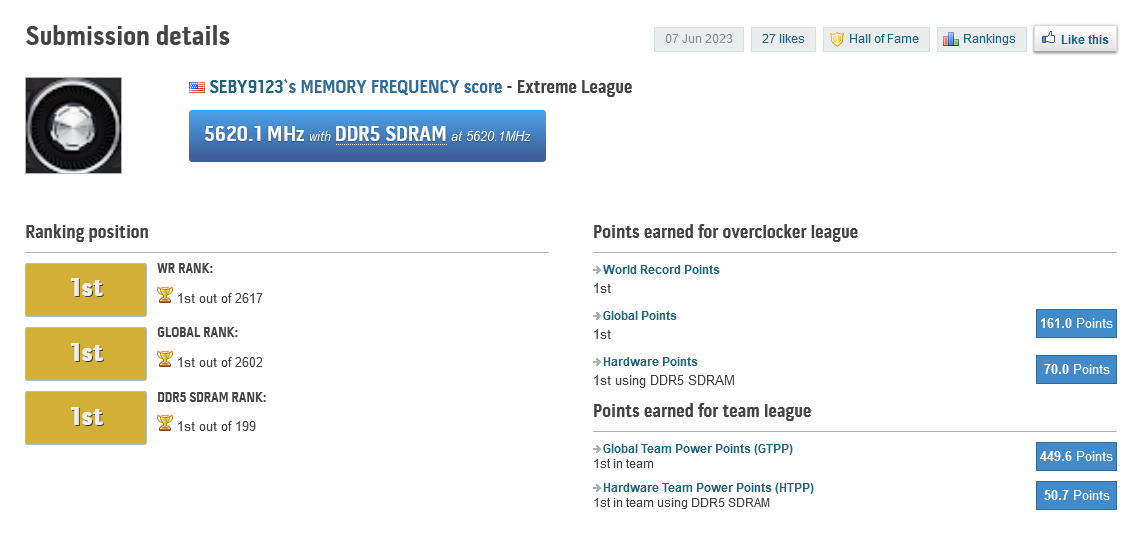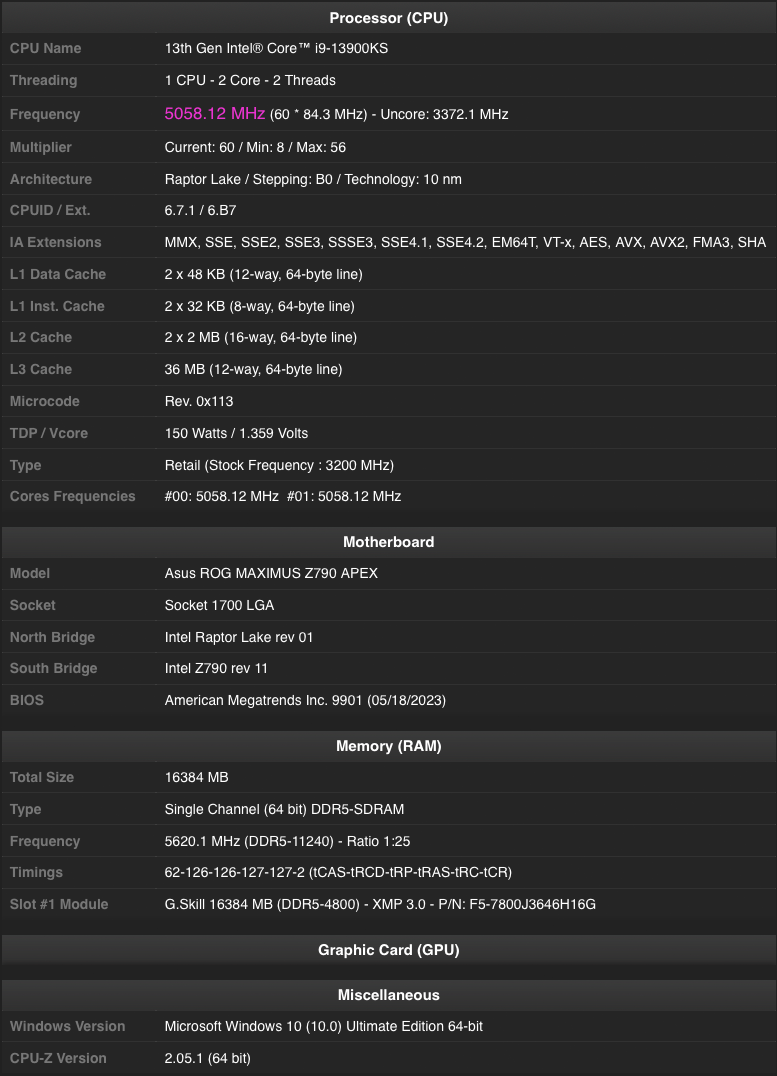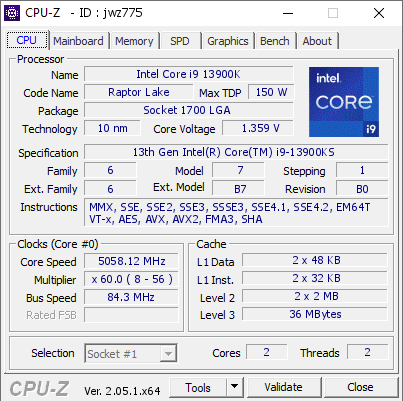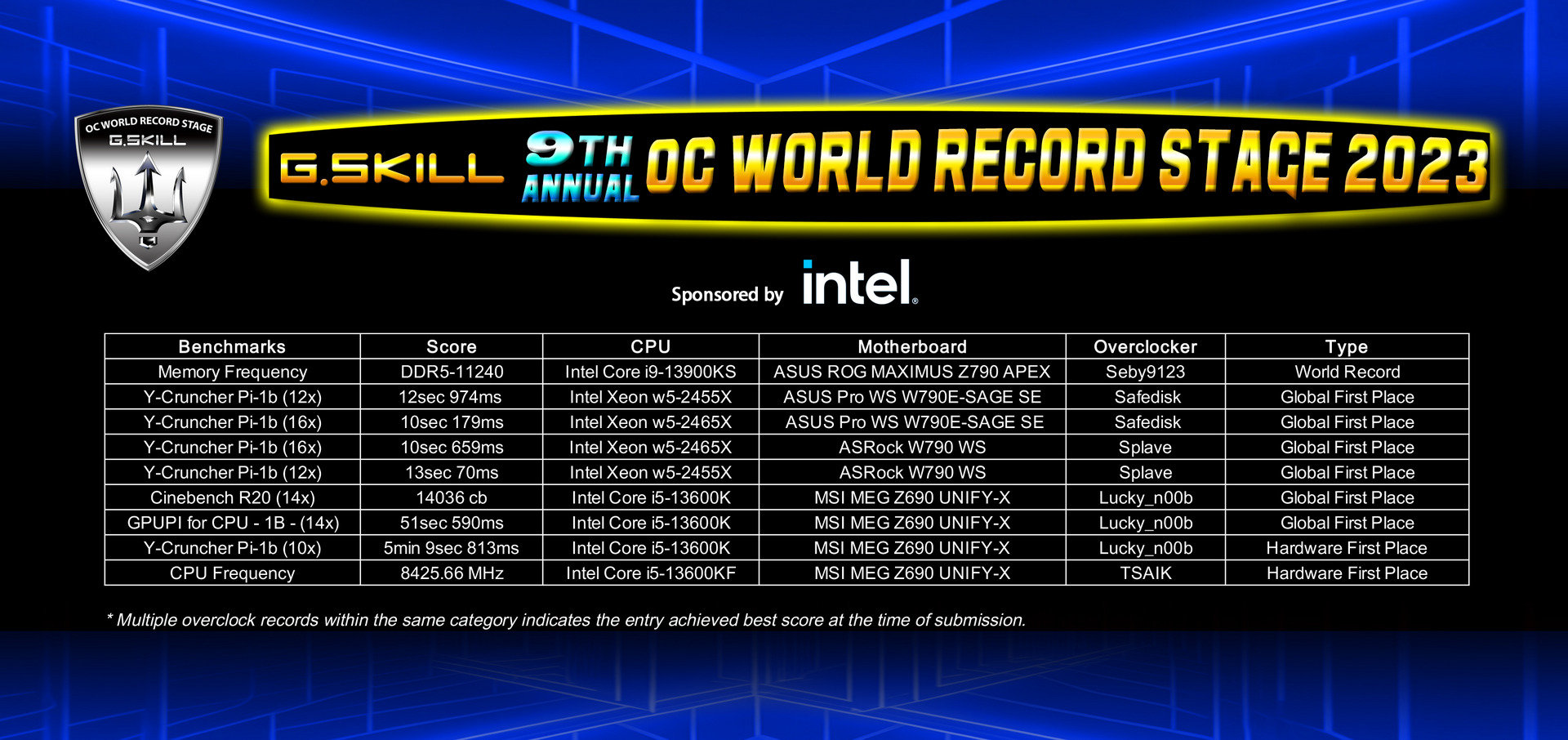G.Skill's DDR5 Hits 11,240 MT/s: A New World's Record
Seby9123 sets a new RAM speed record.

Seby9123, one of the world's top professional overclockers, set a new DDR5 SDRAM data transfer record of 11,240 MT/s at G.Skill's overlocking competition at Computex last week. Using premium hardware, liquid nitrogen, and a lot of magic, he has managed to increase the stock speed of G.Skill's DDR5-7800 module by 44%.
The new world record of 11,240 MT/s set by Seby9123 is just slightly higher than the second-highest result of 11,233 MT/s set by Hicookie on the same day. Meanwhile, the third highest result is noticeably higher than 11,130 MT/s set by lupin_no_museme back in October 2022, so the progress made in a few months by DDR5 is more or less obvious.
To set his memory overclocking record, Seby9123 used Asustek's ROG Maximus X790 Apex motherboard, Intel's Core i9-13900KS processor with only two cores enabled (albeit working at 5.0 GHz), a lot of liquid nitrogen, and a 16 GB G.Skill Trident Z5 RGB DR5-7800 memory module in a single-channel mode. The actual frequency was 5620.1 MHz, and timings were set to CL62 126-126-127-127-2.



Unfortunately, there is no word about DRAM voltage for the memory, but we suspect it is even higher than 1.45V, which is already over 30% higher compared to the standard DDR5 voltage set by JEDEC.
In addition to setting the DDR5 speed record, the world's top extreme overclockers assembled by G.Skill at its contest set several other overclocking records at Computex.
Get Tom's Hardware's best news and in-depth reviews, straight to your inbox.

Anton Shilov is a contributing writer at Tom’s Hardware. Over the past couple of decades, he has covered everything from CPUs and GPUs to supercomputers and from modern process technologies and latest fab tools to high-tech industry trends.
-
Friesiansam Reply
I don't think that matters, as long as rules are applied and enforced consistently. Outside the enthusiast overclocking community though, records like this are irrelevant and, have no bearing on potential performance in normal use.InvalidError said:IMO, overclocking records with most of the CPU disabled shouldn't count. -
bit_user Reply
For CPU overclocking, I'd agree. But, for setting memory overclocking records, I think it's okay - as long as everyone is playing by the same rules (as @Friesiansam said).InvalidError said:IMO, overclocking records with most of the CPU disabled shouldn't count. -
InvalidError Reply
What good are memory overclocking results if you have to cripple the CPU beyond usefulness to achieve sufficiently low noise and non-memory power to make it work? If you throw away meaningful usability for the sake of pushing GHz no matter what, may as well allow people to use DRAM development boards with semi-custom ASICs and FPGAs too.bit_user said:For CPU overclocking, I'd agree. But, for setting memory overclocking records, I think it's okay - as long as everyone is playing by the same rules (as @Friesiansam said). -
bit_user Reply
What use is quarter-mile times, if driving a dragster on the street would be instantly fatal?InvalidError said:What good are memory overclocking results if you have to cripple the CPU beyond usefulness to achieve sufficiently low noise and non-memory power to make it work?
It's just pushing the envelope of technology. That's how I see it. Maybe useful lessons are learned, in the process? -
InvalidError Reply
What useful lessons could possibly be drawn from running chips grossly out of spec at cryogenic temperatures with zero equipment capable of making any scientifically useful measurements attached?bit_user said:It's just pushing the envelope of technology. That's how I see it. Maybe useful lessons are learned, in the process?
At least a dragster (hopefully) carries its parts from the start to finish line.
These overclocking competitions are more like demonstrating that an engine can idle at 20 000 RPM and self-destruct the instant you put an actual load on it. -
Stesmi If we're going to be testing memory, then do everything else as optimal as possible, if that's cherry-picking a CPU with an insane IMC and disabling some cores, so what? We're testing memory, not CPU. If we were testing CPU cores, then sure, but if we're testing memory?Reply
Also, to take the 20 000 RPM example, why don't we just put a 20000LBS load behind the car and see axles and engine parts fly. The parallel is that the IMC works, but if you lessen the load in other areas, can be pushed even further, same as if we remove that 20kLBS load from behind the car. It won't break (lockup/crash/etc).
And why? Because we're not testing the CPU or IMC, we're testing how well the MEMORY holds up. This is a memory world record, not a CPU or IMC world record.
If AMD had a stronger IMC, then would it be cheating using that? No? Why not?
